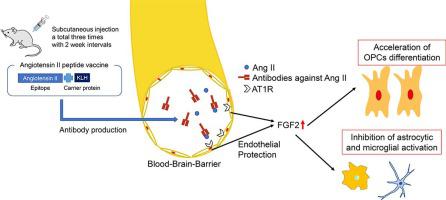Brain Research ( IF 2.9 ) Pub Date : 2021-09-26 , DOI: 10.1016/j.brainres.2021.147667 Kouji Wakayama 1 , Munehisa Shimamura 2 , Shota Yoshida 3 , Hiroki Hayashi 3 , Nan Ju 3 , Hironori Nakagami 3 , Ryuichi Morishita 4

|
Introduction
As several clinical trials have revealed that angiotensin-converting enzyme inhibitors and angiotensin II (Ang II) receptor blockers may be efficient in treating vascular dementia (VaD), the long-acting blockade of the renin-angiotensin system (RAS) would be useful considering the poor adherence of antihypertensive drugs. Accordingly, we continuously blocked RAS via vaccination and examined the effectiveness of the VaD model in rats.
Methods
Male Wistar rats were exposed to two-vessel occlusions (2VO) after three injections of Ang II peptide vaccine. The effects of the vaccine were evaluated in the novel object recognition test, brain RAS components, and markers for oligodendrocytes.
Results
In the vaccinated rats, anti-Ang II antibody titer level was increased in serum until Day 168, but not in cerebral parenchyma. Vaccinated rats showed better object recognition memory with inhibited demyelination in the corpus callosum and activation of astrocytes and microglia. Also, levels of BrdU/GSTπ-positive cells and the phosphorylation of cAMP response element binding protein was increased in vaccinated rats, indicating that the differentiation of oligodendrocyte progenitor cells to mature oligodendrocytes was accelerated. Vaccinated rats showed increased expression of fibroblast growth factor-2 (FGF2), which was observed in endothelial cells. Angiotensinogen mRNA was decreased at 7 days after 2VO but increased at 14 and 28 days.
Conclusion
Ang II vaccine might have promoted oligodendrocyte differentiation and inhibited astrocytic and microglial activation by stimulating FGF2 signaling in the endothelial cells-oligodendrocyte/astrocyte/microglia coupling. These data indicate the feasibility of Ang II vaccine for preventing progression of vascular dementia.
中文翻译:

大鼠模型免疫治疗阻断肾素-血管紧张素系统预防血管性痴呆
介绍
由于几项临床试验表明血管紧张素转换酶抑制剂和血管紧张素 II (Ang II) 受体阻滞剂可能有效治疗血管性痴呆 (VaD),考虑到肾素-血管紧张素系统 (RAS) 的长效阻滞剂将是有用的降压药依从性差。因此,我们通过疫苗接种持续阻断 RAS 并检查 VaD 模型在大鼠中的有效性。
方法
雄性 Wistar 大鼠在注射 Ang II 肽疫苗 3 次后暴露于双血管闭塞 (2VO)。在新的物体识别测试、脑 RAS 成分和少突胶质细胞标记中评估了疫苗的效果。
结果
在接种疫苗的大鼠中,直到第 168 天,血清中的抗-Ang II 抗体滴度水平增加,但脑实质中没有。接种疫苗的大鼠表现出更好的物体识别记忆,胼胝体脱髓鞘受到抑制,星形胶质细胞和小胶质细胞活化。此外,在接种疫苗的大鼠中,BrdU/GSTπ阳性细胞的水平和cAMP反应元件结合蛋白的磷酸化增加,表明少突胶质祖细胞向成熟少突胶质细胞的分化加速。接种疫苗的大鼠显示成纤维细胞生长因子 2 (FGF2) 的表达增加,这在血管内皮细胞中观察到。血管紧张素原 mRNA 在 2VO 后 7 天减少,但在 14 天和 28 天增加。
结论
Ang II 疫苗可能通过刺激内皮细胞-少突胶质细胞/星形胶质细胞/小胶质细胞偶联中的 FGF2 信号传导来促进少突胶质细胞分化并抑制星形胶质细胞和小胶质细胞活化。这些数据表明Ang II疫苗预防血管性痴呆进展的可行性。


























 京公网安备 11010802027423号
京公网安备 11010802027423号